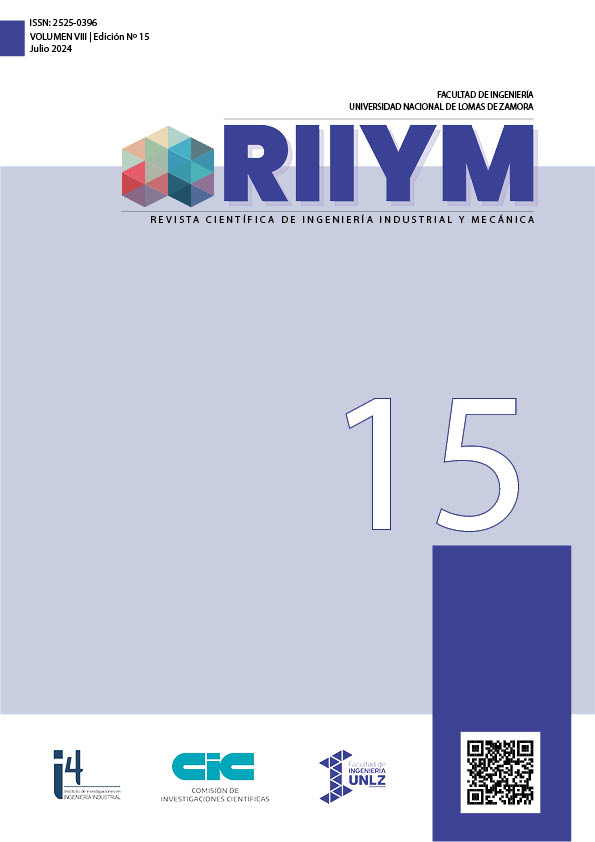SENSITIZATION AND CORROSION IN AISI 316L
Keywords:
Intergranular Corrosion, Heat TreatmentsAbstract
This work studies the accelerated corrosion of AISI 316L stainless steel under exposure to a saline atmosphere for 96h. The samples were previously solution-treated at 1100°C for 1 hour and then cooled in water or air, followed by isothermal sensitization at 650°C for 6 hours. Microstructural analysis, using optical and scanning electron microscopy, revealed severe attacks at the austenitic grain boundaries, attributed to the precipitation of different types of chromium carbides and intermetallic phases, as confirmed by X-ray diffraction. Corrosion tests indicated that the air-cooled sample exhibited a higher degradation rate and mass loss, with significant advancement of intergranular corrosion, compared to the water-cooled one. These findings highlight the influence of heat treatments on susceptibility to localized corrosion.
References
ABD RASHID, M. W., GAKIM, M., ROSLI, Z. M. y ASYADI AZAM, M. Formation of Cr23C6 during the sensitization of aisi 304 stainless steel and its effect to pitting corrosion. International Journal of Electrochemical Science. 2012, vol. 7, 9465-9477. doi: 10.1016/S1452-3981(23)16211-0.
Disponible en: https://www.sciencedirect.com/science/article/pii/S1452398123162110
AFOLABI, A. Y PELEOWO, N. Effect of heat treatment on corrosion behaviour of austenitic stainless steel in mild acid medium. Anales de International Conference on Chemical, Ecology and Environmental Sciences. 2011.
BERTUCELLI, Mariano Javier, INÉS, Mariano Nicolás, DELPUPO, María Noelia y MANSILLA, Graciela Analía. Corrosion study in sae 1016 electrogalvanized steel. XI Corrosion Latinamerican Congress, Latincorr. 2018, 031, 23- 25.
Disponible en: https://www.researchgate.net/publication/329814697_corrosion_study_in_sae_1016_electrogalvanized_steel
GRUBB, J. F., DEBOLD, T. y FRITZ, J.D. Corrosion of Wrought Stainless Steels. ASM International Handbook (tenth edition), Ohio, 2005, p. 54-77.
GILEADI, E. y KIROWA-EISNER, E. Some observations concerning the tafel equation and its relevance to charge transfer in corrosion. Corrosion Science. 2005, vol. 47, 3068-3085. doi: 10.1016/j.corsci.2005.05.044
Disponible en: https://www.sciencedirect.com/science/article/abs/pii/S0010938X05002246
KOCSISOVÁ, E., DOMÁNKOVÁ, M., SLATKOVSKÝ, I. y SAHUL, M. Study of the sensitization on the grain boundary in austenitic stainless steel aisi 316. Research paper, special number, 2014, vol. 22. Doi:10.2478/rput-2014-0019
OHTSUKA, T., UEDA, M. y ABE, M. Aging of passive oxide on SUS304 stainless steel in a sulfuric acid solution. Journal of the Electrochemical Society. 2016, vol. 163, 459-469. doi: 10.1149/2.0721608jes.
Disponible en: https://www.researchgate.net/publication/303782109_Aging_of_Passive_Oxide_on_SUS304_Stainless_Steel_in_a_Sulfuric_Acid_Solution
PADILHA, A. F., LESLEY, R. y RANGEL RIOS, P. Stainless steels heat treatment. Steel Heat Treatment Handbook (second edition), 2007, p. 695-739.
RODRÍGUEZ, C. J., FIGUEROA, Y. y PRIN, J. (2013). Efecto de la temperatura en el comportamiento del acero inoxidable Austenítico 316L frente a la corrosión electroquímica. Saber, Universidad de Venezuela, vol. 25, p. 302-308.
ISSN: 1315-0162.
SAHLAOUI, H., MAKHLOUF, K., MAKHLOUF, H. y PHILIBERT, J. Effects of aging conditions on the precipitates evolution, chromium depletion and intergranular corrosion susceptibility of aisi 316L: experimental and modeling results. Materials Science and Engineering. 2004, vol. 372, p. 98-108. doi: 10.1016/j.msea.2003.12.017.
Disponible en: https://www.sciencedirect.com/science/article/abs/pii/S0921509303014850
SCULLY, J.R. Polarization resistance method for determination of instantaneous corrosion rates. Corrosion Science. 2000, vol. 56, p. 199–218. doi: 10.5006/1.3280536.
Disponible en: https://www.researchgate.net/publication/250394524_Polarization_Resistance_Method_for_Determination_of_Instantaneous_Corrosion_Rates
SULEIMAN, I. Y., SANI, A. M. y CLIFFORD, O. O. Characterization and corrosion behaviours of aisi 316 in hydrochloric environment at various concentrations. Zastita Materijala. 2020, vol. 61, p. 220-228. doi:10.5937/zasmat2003220S.
TALHA, M., MA, Y., LIN, Y., PAN, Y., KONG, X., SINHA, O.P. y BEHERA, C.K. Corrosion performance of cold deformed austenitic stainless steels for biomedical applications. Corrosion Reviews. 2019, vol. 37, p. 283–306. doi: 10.1515/corrrev-2019-0004.
BRIANT, C.L. y HALL, E.L. Corrosion Journal. 1986, vol. 43, 522.
YANIV, A. E., LUMSDEN, J. B. y STAEHLE, R. W. The composition of passive films on ferritic stainless steels. Journal of the Electrochemical Society. 1977, vol. 124, no 4, p. 490.
SOMERVUORI, M., JOHANSSON L. S., HEINONEN, M. H., VAN HOECKE, D. H. D., AKDUT N. y HANNINEN, H. E. Characterisation and Corrosion of Spot Welds of Austenitic Stainless Steels. Materials and Corrosion. 2004, vol. 55, 6, p. 421-436.
Disponible en: https://www.researchgate.net/publication/230398147_Characterisation_and_corrosion_of_spot_welds_of_austenitic_stainless_steels
MC CARTY, K. F. y BOEHME, D. R. A Raman study of the systems Fe3−xCrxO4 and Fe2−xCrxO3. Journal of Solid State Chemistry. 1989, vol. 79, 1, p. 19-27. doi.org/10.1016/0022-4596(89)90245-4.
Disponible en: https://www.sciencedirect.com/science/article/pii/0022459689902454
GONZALES, S., COMBARMOND, L., TRAN, M. T., WOUTERS, Y. y GALERIE A. Materials Science Forum. 2008, p. 595-601.
VON MOLTKE, T., PITSORIUS P. C. y SANDENBERGH. The Influence of Heat-Tinted Surface Layers on the Corrosion Resistance of Stainless Steels. Proceedings of the 1st International Chromium Steel and Alloy Congress. 1992, vol. 2, p. 185-195.
Disponible en: https://www.pyrometallurgy.co.za/InfaconVI/2185-VonMoltke.pdf
FRANKEL, G.S. Corrosion: Fundamentals, Testing, and Protection. ASM International Handbook, 2003, vol. 13A, 236–241.
Downloads
Published
How to Cite
Issue
Section
License
Copyright (c) 2024 MARIANO INÉS

This work is licensed under a Creative Commons Attribution 4.0 International License.
Copyright of the accepted works belongs to their authors, however, access to them is completely open and free, so they may be reproduced in whole or in part with the only limitation of acknowledging authorship and the source of publication.
The Scientific Journal uses the following Open Access license for all its works: CC-BY 4.0










